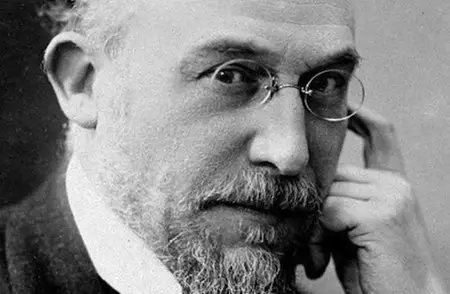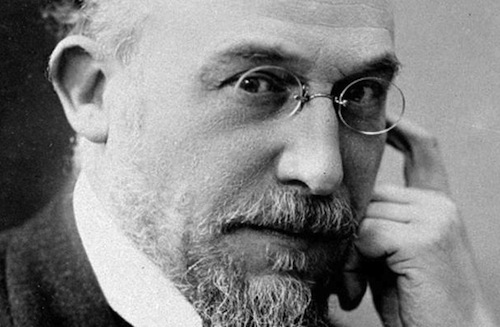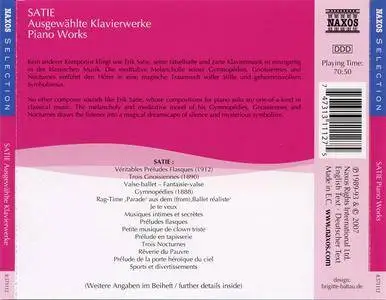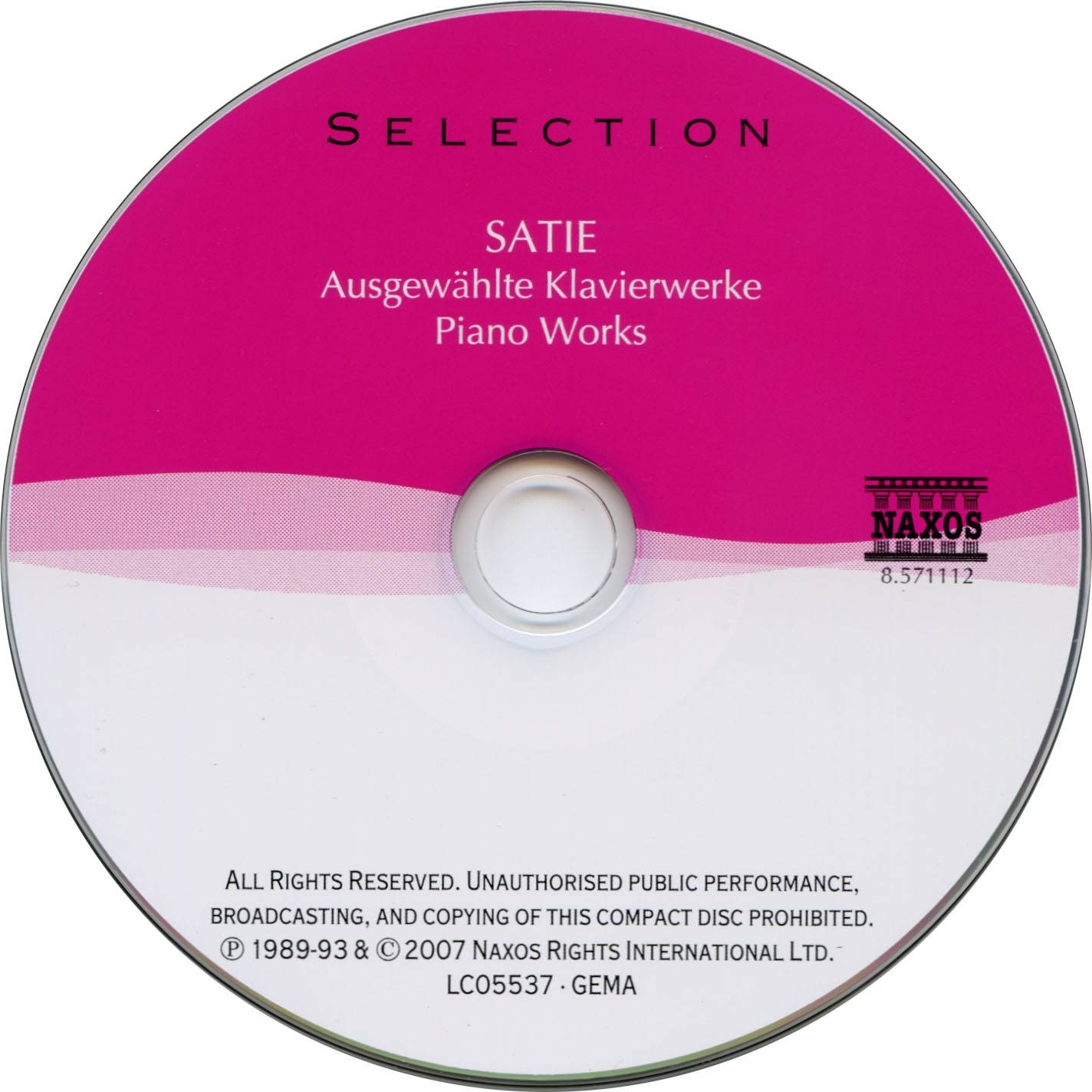Klára Körmendi - Erik Satie: Piano Works (Naxos Selection) (2007)
EAC | WavPack | Image (Cue&Log) ~ 221 Mb | Mp3 (CBR320) ~ 178 Mb | Scans included
Genre: Classical | Label: Naxos | # 8.571112 | Time: 01:12:01
EAC | WavPack | Image (Cue&Log) ~ 221 Mb | Mp3 (CBR320) ~ 178 Mb | Scans included
Genre: Classical | Label: Naxos | # 8.571112 | Time: 01:12:01
The Hungarian pianist Klára Körmendi was born in Budapest and studied under Kornel Zempleni at the Bartók Conservatory, later becoming a student of Peter Solymos at the Liszt Academy, where she received her diploma with distinction in 1967. She enjoyed early success in a number of national competitions, before embarking on a career that has taken her to the major musical centres of Europe, with broadcasts in Vienna, Paris and London, as well as Basie, Cologne, Lausanne and Lubljana. Klara Kormendi has a wide repertoire, and has always shown particular interest in contemporary repertoire, both Hungarian and foreign. Her recordings for Hungaroton include music by Pierre Boulez, Oliver Messiaen, Luciano Berio and Heinz Hollinger. For Naxos she has recorded works by Debussy and Ravel and the complete piano music of Eric Satie.
The French composer Erik Satie earned himself a contemporary reputation as an eccentric. Stravinsky later described him as the oddest person he had ever known and at the same time the most rare and consistently witty. His musical innovations proved immensely influential on his nearer contemporaries Debussy and Ravel and on a younger generation of composers and artists in the years after the war of 1914.
Satie was born in 1866 at Honfleur, on the coast of Normandy. His father was, at the time, a ship's broker, while his mother was of Scottish origin. Something of later eccentricity seems to have been acquired from his paternal uncle, Adrien Satie, known in Honfleur as a character. The family moved to Paris, but on the death of Satie's mother in 1872 he was sent back to Honfleur to the house of his grandparents. Six years later he returned to Paris, where, in 1879 he entered the Paris Conservatoire. There he was to prove an undistinguished and unsatisfactory pupil, lingering on, according to one friend, in order to avoid the obligatory five years of military service. His status as a student allowed him a period of one year in the 33rd Infantry, cut short by a severe attack of bronchitis that he had deliberately courted.
Satie's few months of soldiering were followed by the first publications of his music, two piano pieces, and then a set of five songs, settings of poems by his friend Contamine de Latour, published by his father, who now had a stationer's shop and small publishing business. Inspired by his reading, in the early 1890s Satie came for a time under the influence of the extraordinary Joséphin Péladan, self-styled Sâr Merodack of the Rose + Croix, an eccentric exponent of Rosicrucianism, with whom he had broken by 1892. Eclectic medieval preoccupations led him to establish his own mock religion, the Metropolitan Church of the Art of Jesus the Conductor. Of this he described himself fancifully as Parcier et Maître de Chapelle, the first title sheer invention, issuing his publication, Le cartulaire, in which critical enemies were attacked in appropriate style. At the same time, paradoxically, he was involved with Rudolf Salis and his bohemian cabaret, the Chat noir. The same years brought contact with Debussy, with whom he remained on good terms in the years that followed, in spite of the latter's tendency to patronise him.
In 1905, after a period in which he had been compelled to earn his living as a café pianist and a composer of appropriate music Satie enrolled as a student at the Schola cantorum, where his teachers included Vincent d'lndy and Roussel. Here he attempted to make up for technical deficiencies in his techniques as a composer by a concentration on traditional counterpoint. He completed his studies in 1908, but only began to win some success through the agency of Ravel, who in 1911 performed the three Sarabandes that Satie had written in 1887, establishing the innovative originality of Satie's early work. The following years brought his compositions before a wider public, but it was through the advocacy of Jean Cocteau that Satie's fame was more firmly established, particularly with collaboration in the Dyagilev ballet Parade, with choreography by Massin and décor by Picasso. The scandal of the first performance in May 1917 made Satie a hero to a younger group of composers, to be known as Les Six. In 1923, under the inspiration of Darius Milhaud, his collaborator in musique d'ameublement, furniture music that was not supposed to be listened to, he became the centre of another group of younger composers, the Ecole d' Arceuil, its name derived from the poor and relatively remote district of Paris where Satie had lived a life of the utmost simplicity, his room furnished with a chair, a table and a hammock, the last heated in winter by bottles filled with hot water placed below and looking, Stravinsky tells us, like some strange kind of marimba. He died on 1st July, 1925, after an illness of some six months.
Satie wrote for the theatre, and particularly for dancers. His compositions include songs, chamber music and, above all, piano pieces of surprising simplicity, apparent ingenuousness, and harmonic originality, often embellished with titles or instructions that defy idiomatic translation. The three Véritables préludes flasques, three really flabby preludes, were written in 1912, for a dog, and are far from flabby. The first, Sévère réprimande, is severely contrapuntal, the second, Seul à la maison, Alone in the house, delicately so, and the third, On joue, play-time, more energetic. Preposterous directions in the score are given in dog-Latin.
The first three Gnossiennes were written in 1890, the fourth in 1891, the fifth in 1889 and the sixth in 1897. The title, a mysterious one, suggests the world of Minoan Cnossos and the labyrinth, while the score, written without bar-lines, includes bizarre instructions to the player - du bout de la pensée, from the tip of the thought, sur la langue, on the tip of the tongue, sans orgueil, without pride, and dans une saine superiorité, with healthy superiority. Eccentric witticisms of this kind are visible only to the performer.
The Menus propos enfantins of 1913 and the Enfantillages pittoresques of the same year are real children's pieces. The first starts with the war-song of the king of the beans, proceeding to the words of the princess of the tulips and the waltz of the chocolate almonds. The second group, more conventional in titles, starts with a little prelude to the day, followed by a cradle-song and the march of the grand staircase, so grand that no-one dared to use it and the king used to jump out of the window instead. Croquis et agaceries d'un gros bonhomme en bois, sketches and provocations of a portly wooden man, contains three parodies, the first a Turkish Tyrolean dance, the second a thin dance, in the manner of these gentlemen, and the third making fun of Chabrier and Debussy in Spanish vein, including remarks on the score - Puerta Maillot, Plaza Clichy and A la disposicion de Usted.
Chapitres tournés en tous sens, chapters turned in all directions, opens with a woman who talks too much, demanding a hat in massive mahogany, and prattling on until her husband dies of exhaustion. The man carrying great stones amazes by his strength (he is only carrying a pumice stone) and includes the quotation from a popular operetta "C'est un rien, un souffle." In the regrets of those shut in, dedicated to Debussy's second wife, the popular song “Nous n'irons plus au bois”, quoted by Debussy in Jardins sous la pluie, is used ironically.
The three Desciptions automatiques are equally characteristic in their allusive parody. The first, Sur un vaisseau, on a ship, quotes the song “Maman, les petits bateaux”, and Sur la lanterne, a current music-hall song, while the third, Sur un casque, on a helmet, completes the typical trilogy. Embryons desséchés, desiccated embryos, of the same year, 1913, indulges in remoter fantasy, with imaginary descriptions of three marine creatures. Holothurie, the sea-cucumber, is said to climb about on stones and rocks and to purr like a cat. Satie claims to have observed one at St. Malo, and opens the piece with a version of the song “Mon rocher de St. Malo”. Edriophthalma are described as crustaceans with sessile eyes and by nature of a sad disposition, dignified here by quotation of Chopin's Funeral March, identified ironically in the score as a Schubert Mazurka. Podophthalma, skilful and indefatigable hunters, are restrained by an injunction in the score, Ah! Ne courez pas commme ça, and end in an obligatory and emphatic cadence - cadence obligée - de lauteur.
The three Gymnopédies, their title derived from the festival dance of naked boys in ancient Sparta, were written in 1888. The first and third of the group were later orchestrated by Debussy. In their solemn simplicity they prefigure remarkably one path that French music was to take. The Passacaille, a product of Satie's years of study at the Schola cantorum, was published posthumously, a record of his contrapuntal achievement, and the final six pieces, the titles of which are apparently not the composer's, came from the period of his life before his emergence in 1913 in the role of all-licensed fool, his witty clowning in part a defence in the company of his well established contemporaries Debussy, and, in these years, Ravel.
Klára Körmendi
Tracklist:
Erik Satie (1866 -1925)
01. Veritables Preludes Flasques (2:48)
02. Trois Gnossiennes - Lent (3:11)
03. Trois Gnossiennes - Avec Etonnement (1:38)
04. Trois Gnossiennes - Lent (2:30)
05. Valse-Ballet - Fantasie-Valse (4:48)
06. Gymnopedies - 1Ere Gymnopedie: Lent Et Douloureux (2:39)
07. Gymnopedies - 2Eme Gymnopedie: Lent Et Triste (2:12)
08. Gymnopedies - 3Me Gymnopedie: Lent Et Grave (2:04)
09. Rag-Time Parade From Ballet Realiste (2:39)
10. Petite Ouverture A Danser (1:30)
11. Je Te Veux (4:27)
12. Musiques Intimes Et Secretes (2:57)
13. Preludes Flasques (4:42)
14. Petite Musique De Clown Triste (2:03)
15. Prelude En Tapisserie (2:24)
16. Trois Nocturnes - Le Premiere (2:28)
17. Trois Nocturnes - Le Deuxieme (1:49)
18. Trois Nocturnes - Le Troisieme (2:31)
19. Reverie Du Pauvre (4:13)
20. Prelude De La Porte Heroique Du Ciel (3:34)
21. Sports Et Divertissements (20 Courtes Pieces) (14:52)
Exact Audio Copy V0.99 prebeta 5 from 4. May 2009
EAC extraction logfile from 3. October 2009, 7:01
Klara Kormendi / Satie - Piano Works
Used drive : HL-DT-STDVD-ROM DH16NS10 Adapter: 5 ID: 0
Read mode : Secure
Utilize accurate stream : Yes
Defeat audio cache : Yes
Make use of C2 pointers : No
Read offset correction : 102
Overread into Lead-In and Lead-Out : No
Fill up missing offset samples with silence : Yes
Delete leading and trailing silent blocks : No
Null samples used in CRC calculations : Yes
Used interface : Installed external ASPI interface
Used output format : Internal WAV Routines
Sample format : 44.100 Hz; 16 Bit; Stereo
TOC of the extracted CD
Track | Start | Length | Start sector | End sector
––––––––––––––––––––––––––––-
1 | 0:00.00 | 2:47.41 | 0 | 12565
2 | 2:47.41 | 3:10.47 | 12566 | 26862
3 | 5:58.13 | 1:38.10 | 26863 | 34222
4 | 7:36.23 | 2:30.37 | 34223 | 45509
5 | 10:06.60 | 4:48.35 | 45510 | 67144
6 | 14:55.20 | 2:39.22 | 67145 | 79091
7 | 17:34.42 | 2:12.35 | 79092 | 89026
8 | 19:47.02 | 2:03.41 | 89027 | 98292
9 | 21:50.43 | 2:38.73 | 98293 | 110215
10 | 24:29.41 | 1:30.29 | 110216 | 116994
11 | 25:59.70 | 4:27.37 | 116995 | 137056
12 | 30:27.32 | 2:57.07 | 137057 | 150338
13 | 33:24.39 | 4:42.24 | 150339 | 171512
14 | 38:06.63 | 2:02.52 | 171513 | 180714
15 | 40:09.40 | 2:23.55 | 180715 | 191494
16 | 42:33.20 | 2:28.04 | 191495 | 202598
17 | 45:01.24 | 1:49.00 | 202599 | 210773
18 | 46:50.24 | 2:31.19 | 210774 | 222117
19 | 49:21.43 | 4:12.72 | 222118 | 241089
20 | 53:34.40 | 3:34.29 | 241090 | 257168
21 | 57:08.69 | 14:52.06 | 257169 | 324074
Range status and errors
Selected range
Filename F:\Release\Satie - Piano Works\Klara Kormendi - Satie - Piano Works.wav
Peak level 90.4 %
Range quality 100.0 %
Test CRC 3CC8DAEE
Copy CRC 3CC8DAEE
Copy OK
No errors occurred
AccurateRip summary
Track 1 not present in database
Track 2 not present in database
Track 3 not present in database
Track 4 not present in database
Track 5 not present in database
Track 6 not present in database
Track 7 not present in database
Track 8 not present in database
Track 9 not present in database
Track 10 not present in database
Track 11 not present in database
Track 12 not present in database
Track 13 not present in database
Track 14 not present in database
Track 15 not present in database
Track 16 not present in database
Track 17 not present in database
Track 18 not present in database
Track 19 not present in database
Track 20 not present in database
Track 21 not present in database
None of the tracks are present in the AccurateRip database
End of status report
EAC extraction logfile from 3. October 2009, 7:01
Klara Kormendi / Satie - Piano Works
Used drive : HL-DT-STDVD-ROM DH16NS10 Adapter: 5 ID: 0
Read mode : Secure
Utilize accurate stream : Yes
Defeat audio cache : Yes
Make use of C2 pointers : No
Read offset correction : 102
Overread into Lead-In and Lead-Out : No
Fill up missing offset samples with silence : Yes
Delete leading and trailing silent blocks : No
Null samples used in CRC calculations : Yes
Used interface : Installed external ASPI interface
Used output format : Internal WAV Routines
Sample format : 44.100 Hz; 16 Bit; Stereo
TOC of the extracted CD
Track | Start | Length | Start sector | End sector
––––––––––––––––––––––––––––-
1 | 0:00.00 | 2:47.41 | 0 | 12565
2 | 2:47.41 | 3:10.47 | 12566 | 26862
3 | 5:58.13 | 1:38.10 | 26863 | 34222
4 | 7:36.23 | 2:30.37 | 34223 | 45509
5 | 10:06.60 | 4:48.35 | 45510 | 67144
6 | 14:55.20 | 2:39.22 | 67145 | 79091
7 | 17:34.42 | 2:12.35 | 79092 | 89026
8 | 19:47.02 | 2:03.41 | 89027 | 98292
9 | 21:50.43 | 2:38.73 | 98293 | 110215
10 | 24:29.41 | 1:30.29 | 110216 | 116994
11 | 25:59.70 | 4:27.37 | 116995 | 137056
12 | 30:27.32 | 2:57.07 | 137057 | 150338
13 | 33:24.39 | 4:42.24 | 150339 | 171512
14 | 38:06.63 | 2:02.52 | 171513 | 180714
15 | 40:09.40 | 2:23.55 | 180715 | 191494
16 | 42:33.20 | 2:28.04 | 191495 | 202598
17 | 45:01.24 | 1:49.00 | 202599 | 210773
18 | 46:50.24 | 2:31.19 | 210774 | 222117
19 | 49:21.43 | 4:12.72 | 222118 | 241089
20 | 53:34.40 | 3:34.29 | 241090 | 257168
21 | 57:08.69 | 14:52.06 | 257169 | 324074
Range status and errors
Selected range
Filename F:\Release\Satie - Piano Works\Klara Kormendi - Satie - Piano Works.wav
Peak level 90.4 %
Range quality 100.0 %
Test CRC 3CC8DAEE
Copy CRC 3CC8DAEE
Copy OK
No errors occurred
AccurateRip summary
Track 1 not present in database
Track 2 not present in database
Track 3 not present in database
Track 4 not present in database
Track 5 not present in database
Track 6 not present in database
Track 7 not present in database
Track 8 not present in database
Track 9 not present in database
Track 10 not present in database
Track 11 not present in database
Track 12 not present in database
Track 13 not present in database
Track 14 not present in database
Track 15 not present in database
Track 16 not present in database
Track 17 not present in database
Track 18 not present in database
Track 19 not present in database
Track 20 not present in database
Track 21 not present in database
None of the tracks are present in the AccurateRip database
End of status report
[CUETools log; Date: 02.04.2018 1:09:23; Version: 2.1.4]
[CTDB TOCID: Af92Vwj1hKdhB_3bhl3mODBLW9Q-] disk not present in database.
[AccurateRip ID: 002d4d2a-02bddf56-1f10e115] found.
Track [ CRC | V2 ] Status
01 [715d070b|b14f74f7] (1+0/1) Accurately ripped
02 [7f425d4e|b2bc2882] (1+0/1) Accurately ripped
03 [73806dbf|10d4f5a1] (1+0/1) Accurately ripped
04 [6fe29e82|96b01c66] (1+0/1) Accurately ripped
05 [98832c11|52059e39] (1+0/1) Accurately ripped
06 [8fe2f16d|40efd061] (1+0/1) Accurately ripped
07 [a60831aa|8ce91c97] (1+0/1) Accurately ripped
08 [8deea567|a0885a6e] (1+0/1) Accurately ripped
09 [5714bc2f|2e3b477d] (1+0/1) Accurately ripped
10 [7ca7ad25|16d55df8] (1+0/1) Accurately ripped
11 [f5313d6a|f0c45625] (1+0/1) Accurately ripped
12 [97e86d65|791bf9f3] (1+0/1) Accurately ripped
13 [64e9fc49|31a50b1a] (1+0/1) Accurately ripped
14 [16cbe2a3|8bac206a] (1+0/1) Accurately ripped
15 [cebe1ec4|18a7b4e2] (1+0/1) Accurately ripped
16 [90a91310|8dbc1c84] (1+0/1) Accurately ripped
17 [5360b20e|be282648] (1+0/1) Accurately ripped
18 [8cd88f00|7027d5a8] (1+0/1) Accurately ripped
19 [de4d36da|50cc251b] (1+0/1) Accurately ripped
20 [31072796|40f6cdbc] (1+0/1) Accurately ripped
21 [b0ddabd0|a7cf0e16] (1+0/1) Accurately ripped
Track Peak [ CRC32 ] [W/O NULL] [ LOG ]
– 90,4 [3CC8DAEE] [06EBE39D] CRC32
01 89,8 [B3078F46] [95049BD1]
02 47,6 [BB80BB94] [D9E6FB78]
03 47,8 [2C6F792F] [DC6FEA34]
04 57,0 [4DE6F951] [0BB25DC8]
05 87,8 [B164521F] [77901070]
06 27,1 [EB70D0FD] [81B03E4F]
07 33,4 [1DF898FB] [901FBC32]
08 28,1 [800E3CB8] [89425E46]
09 79,4 [5154725E] [03885A45]
10 35,6 [26CA4588] [D1B0BD2C]
11 54,6 [95205DA2] [C4AC8073]
12 30,1 [7AFFEDCF] [9B6593B1]
13 64,9 [1097CE04] [059D09F4]
14 57,3 [57614319] [49774A2C]
15 61,6 [D01C54C6] [BC6109A5]
16 60,3 [5CDE4818] [315028FD]
17 38,5 [82D4B8AB] [5B8B2093]
18 58,5 [89B01D91] [EB5D1FBF]
19 28,4 [E737DB56] [457220A8]
20 48,6 [846F441F] [96DD361B]
21 90,4 [0BBE155E] [816AE063]
[CTDB TOCID: Af92Vwj1hKdhB_3bhl3mODBLW9Q-] disk not present in database.
[AccurateRip ID: 002d4d2a-02bddf56-1f10e115] found.
Track [ CRC | V2 ] Status
01 [715d070b|b14f74f7] (1+0/1) Accurately ripped
02 [7f425d4e|b2bc2882] (1+0/1) Accurately ripped
03 [73806dbf|10d4f5a1] (1+0/1) Accurately ripped
04 [6fe29e82|96b01c66] (1+0/1) Accurately ripped
05 [98832c11|52059e39] (1+0/1) Accurately ripped
06 [8fe2f16d|40efd061] (1+0/1) Accurately ripped
07 [a60831aa|8ce91c97] (1+0/1) Accurately ripped
08 [8deea567|a0885a6e] (1+0/1) Accurately ripped
09 [5714bc2f|2e3b477d] (1+0/1) Accurately ripped
10 [7ca7ad25|16d55df8] (1+0/1) Accurately ripped
11 [f5313d6a|f0c45625] (1+0/1) Accurately ripped
12 [97e86d65|791bf9f3] (1+0/1) Accurately ripped
13 [64e9fc49|31a50b1a] (1+0/1) Accurately ripped
14 [16cbe2a3|8bac206a] (1+0/1) Accurately ripped
15 [cebe1ec4|18a7b4e2] (1+0/1) Accurately ripped
16 [90a91310|8dbc1c84] (1+0/1) Accurately ripped
17 [5360b20e|be282648] (1+0/1) Accurately ripped
18 [8cd88f00|7027d5a8] (1+0/1) Accurately ripped
19 [de4d36da|50cc251b] (1+0/1) Accurately ripped
20 [31072796|40f6cdbc] (1+0/1) Accurately ripped
21 [b0ddabd0|a7cf0e16] (1+0/1) Accurately ripped
Track Peak [ CRC32 ] [W/O NULL] [ LOG ]
– 90,4 [3CC8DAEE] [06EBE39D] CRC32
01 89,8 [B3078F46] [95049BD1]
02 47,6 [BB80BB94] [D9E6FB78]
03 47,8 [2C6F792F] [DC6FEA34]
04 57,0 [4DE6F951] [0BB25DC8]
05 87,8 [B164521F] [77901070]
06 27,1 [EB70D0FD] [81B03E4F]
07 33,4 [1DF898FB] [901FBC32]
08 28,1 [800E3CB8] [89425E46]
09 79,4 [5154725E] [03885A45]
10 35,6 [26CA4588] [D1B0BD2C]
11 54,6 [95205DA2] [C4AC8073]
12 30,1 [7AFFEDCF] [9B6593B1]
13 64,9 [1097CE04] [059D09F4]
14 57,3 [57614319] [49774A2C]
15 61,6 [D01C54C6] [BC6109A5]
16 60,3 [5CDE4818] [315028FD]
17 38,5 [82D4B8AB] [5B8B2093]
18 58,5 [89B01D91] [EB5D1FBF]
19 28,4 [E737DB56] [457220A8]
20 48,6 [846F441F] [96DD361B]
21 90,4 [0BBE155E] [816AE063]
foobar2000 1.2 / Dynamic Range Meter 1.1.1
log date: 2018-04-01 23:47:16
––––––––––––––––––––––––––––––––––––––––
Analyzed: Klara Kormendi / Satie - Piano Works
––––––––––––––––––––––––––––––––––––––––
DR Peak RMS Duration Track
––––––––––––––––––––––––––––––––––––––––
DR12 -0.93 dB -18.78 dB 2:48 01-Veritables Preludes Flasques
DR12 -6.44 dB -24.29 dB 3:11 02-Trois Gnossiennes - Lent
DR11 -6.40 dB -24.98 dB 1:38 03-Trois Gnossiennes - Avec Etonnement
DR12 -4.88 dB -24.94 dB 2:30 04-Trois Gnossiennes - Lent
DR13 -1.12 dB -21.06 dB 4:48 05-Valse-Ballet - Fantasie-Valse
DR13 -11.32 dB -29.51 dB 2:39 06-Gymnopedies - 1Ere Gymnopedie: Lent Et Douloureux
DR13 -9.50 dB -27.78 dB 2:12 07-Gymnopedies - 2Eme Gymnopedie: Lent Et Triste
DR12 -11.02 dB -29.59 dB 2:04 08-Gymnopedies - 3Me Gymnopedie: Lent Et Grave
DR13 -2.00 dB -19.04 dB 2:39 09-Rag-Time Parade From Ballet Realiste
DR11 -8.96 dB -24.94 dB 1:30 10-Petite Ouverture A Danser
DR12 -5.24 dB -21.96 dB 4:27 11-Je Te Veux
DR12 -10.42 dB -27.50 dB 2:57 12-Musiques Intimes Et Secretes
DR15 -3.75 dB -24.31 dB 4:42 13-Preludes Flasques
DR13 -4.84 dB -23.14 dB 2:03 14-Petite Musique De Clown Triste
DR13 -4.20 dB -22.41 dB 2:24 15-Prelude En Tapisserie
DR11 -4.39 dB -23.19 dB 2:28 16-Trois Nocturnes - Le Premiere
DR11 -8.27 dB -25.76 dB 1:49 17-Trois Nocturnes - Le Deuxieme
DR13 -4.66 dB -23.33 dB 2:31 18-Trois Nocturnes - Le Troisieme
DR16 -10.93 dB -31.62 dB 4:13 19-Reverie Du Pauvre
DR13 -6.26 dB -25.18 dB 3:34 20-Prelude De La Porte Heroique Du Ciel
DR15 -0.87 dB -22.08 dB 14:52 21-Sports Et Divertissements (20 Courtes Pieces)
––––––––––––––––––––––––––––––––––––––––
Number of tracks: 21
Official DR value: DR13
Samplerate: 44100 Hz
Channels: 2
Bits per sample: 16
Bitrate: 403 kbps
Codec: WavPack
================================================================================
log date: 2018-04-01 23:47:16
––––––––––––––––––––––––––––––––––––––––
Analyzed: Klara Kormendi / Satie - Piano Works
––––––––––––––––––––––––––––––––––––––––
DR Peak RMS Duration Track
––––––––––––––––––––––––––––––––––––––––
DR12 -0.93 dB -18.78 dB 2:48 01-Veritables Preludes Flasques
DR12 -6.44 dB -24.29 dB 3:11 02-Trois Gnossiennes - Lent
DR11 -6.40 dB -24.98 dB 1:38 03-Trois Gnossiennes - Avec Etonnement
DR12 -4.88 dB -24.94 dB 2:30 04-Trois Gnossiennes - Lent
DR13 -1.12 dB -21.06 dB 4:48 05-Valse-Ballet - Fantasie-Valse
DR13 -11.32 dB -29.51 dB 2:39 06-Gymnopedies - 1Ere Gymnopedie: Lent Et Douloureux
DR13 -9.50 dB -27.78 dB 2:12 07-Gymnopedies - 2Eme Gymnopedie: Lent Et Triste
DR12 -11.02 dB -29.59 dB 2:04 08-Gymnopedies - 3Me Gymnopedie: Lent Et Grave
DR13 -2.00 dB -19.04 dB 2:39 09-Rag-Time Parade From Ballet Realiste
DR11 -8.96 dB -24.94 dB 1:30 10-Petite Ouverture A Danser
DR12 -5.24 dB -21.96 dB 4:27 11-Je Te Veux
DR12 -10.42 dB -27.50 dB 2:57 12-Musiques Intimes Et Secretes
DR15 -3.75 dB -24.31 dB 4:42 13-Preludes Flasques
DR13 -4.84 dB -23.14 dB 2:03 14-Petite Musique De Clown Triste
DR13 -4.20 dB -22.41 dB 2:24 15-Prelude En Tapisserie
DR11 -4.39 dB -23.19 dB 2:28 16-Trois Nocturnes - Le Premiere
DR11 -8.27 dB -25.76 dB 1:49 17-Trois Nocturnes - Le Deuxieme
DR13 -4.66 dB -23.33 dB 2:31 18-Trois Nocturnes - Le Troisieme
DR16 -10.93 dB -31.62 dB 4:13 19-Reverie Du Pauvre
DR13 -6.26 dB -25.18 dB 3:34 20-Prelude De La Porte Heroique Du Ciel
DR15 -0.87 dB -22.08 dB 14:52 21-Sports Et Divertissements (20 Courtes Pieces)
––––––––––––––––––––––––––––––––––––––––
Number of tracks: 21
Official DR value: DR13
Samplerate: 44100 Hz
Channels: 2
Bits per sample: 16
Bitrate: 403 kbps
Codec: WavPack
================================================================================











